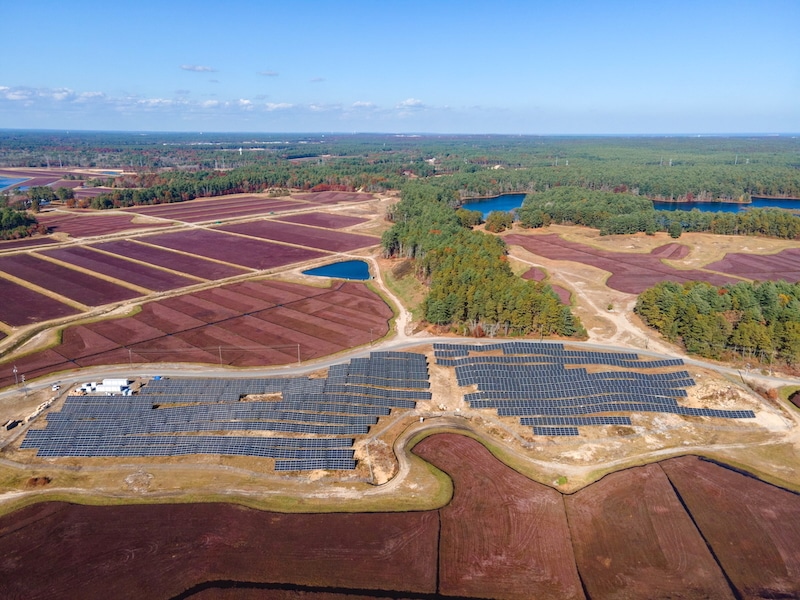This post was originally published on Eco Watch
The site of a cranberry bog in Carver, Massachusetts now serves double-duty as a community solar plant after receiving Permission to Operate approval on November 26.
The Carver Solar project, owned by New York-based solar developer and operator Syncarpha Capital, sits on 28 acres leased by E.J. Pontiff Cranberries Inc. in an overall 765-acre plot otherwise used for cranberry bogs.
According to Syncarpha Capital, the community solar installation has a 7.1 MW-DC capacity, along with a 4 MW, 2-hour battery storage system, with the generated energy to be shared among local residents and institutions. The energy will be distributed to recipients by energy provider Eversource Energy via the state’s solar incentive program known as Solar Massachusetts Renewable Target (SMART).
Around 350 low-income residents, as well as Tufts University and Milton Academy, will receive discounted solar energy credits through the project, which is expected to generate around 9,500 MWh of clean energy in its first year of operation.
In addition to generating solar energy, the Carver Solar project features a battery installation that will help store energy collected from the solar panels, making it easier to meet energy demand during peak times. Ultimately, this helps build grid resilience to power outages.
Another benefit of establishing community solar is that it allows multiple households, businesses and institutions to access clean energy from one source, rather than households needing to pay for individual solar installations. Community solar can make clean energy more accessible, particularly to low-income households.
According to Solar Gardens, an energy provider by Syncarpha Capital, its community solar projects do not require enrollment fees. Instead, participants receive credits toward their energy bills for using the community solar.
The U.S. Department of Energy reported that as of June 2024, there are about 7.87 GW of community solar projects operating in at least 44 states and Washington, DC. Customers receive a median net present value savings of around $0.27 per watt (W-AC), with total savings varying by project.
Community solar can also be beneficial by incorporating dual-purpose land strategies, Syncarpha Capital reported, or by transforming otherwise unused brownfields into clean energy projects. For example, the site of an old landfill in New York was recently transformed into a community solar site, and in Michigan, some former coal sites are being transitioned into solar hubs and wildlife areas.
“The Syncarpha team thrives on tackling challenging projects and delivering innovative solar and storage solutions that benefit communities while respecting and preserving local land use,” said Clifford Chapman, co-founder and CEO of Syncarpha Capital.
The Carver Solar project is not without controversy, though. As Axios reported, farmers can be skeptical of installing solar on farmland, because it can make it more difficult to operate machinery around solar panels and there are concerns over whether solar could become more profitable than growing food, leading to shortages.
A local group known as Carver Concerned Citizens expressed concerns particularly over how solar installations could affect cranberry bogs, noting that the wooden poles for solar panel installation may be treated with chromated copper arsenate (CCA). The group said these poles could contaminate the cranberries and local drinking water.
Previously, the group campaigned for the removal of chemically treated poles from separate projects under Pine Gate Renewables. Carver Conservation Commission voted in 2021 for the poles to be removed and replaced by alternatives such as pre-cast concrete, Wicked Local reported.
In response to the rise of solar installations on agricultural lands, Carver Concerned Citizens said in a Facebook post in 2022, “Carver is home to a wide range of small family farms that could be threatened by irresponsible solar development. Let’s make sure that our farms keep producing food!”
The post Massachusetts Cranberry Bog Hosts Community Solar Plant appeared first on EcoWatch.





0 Comments